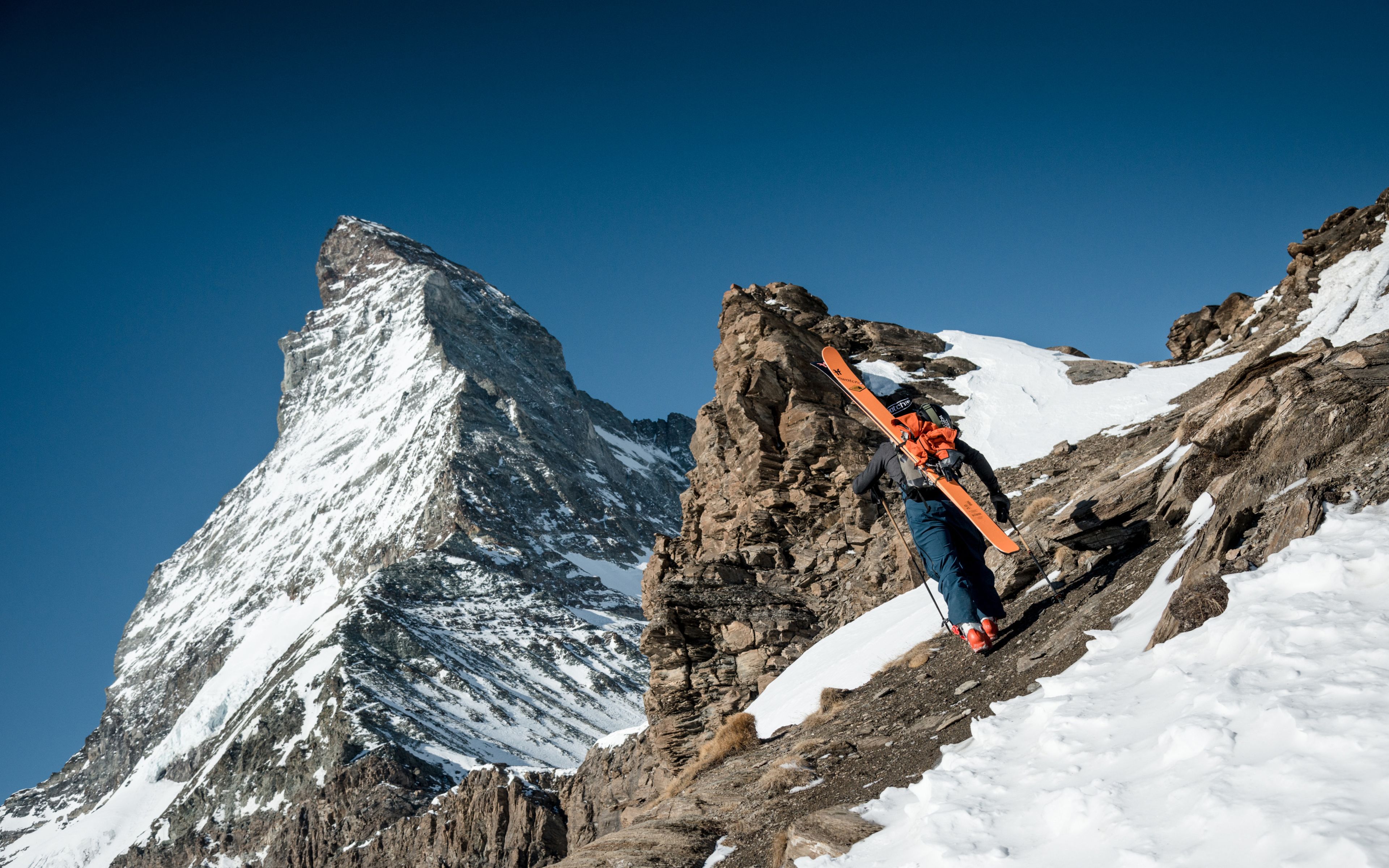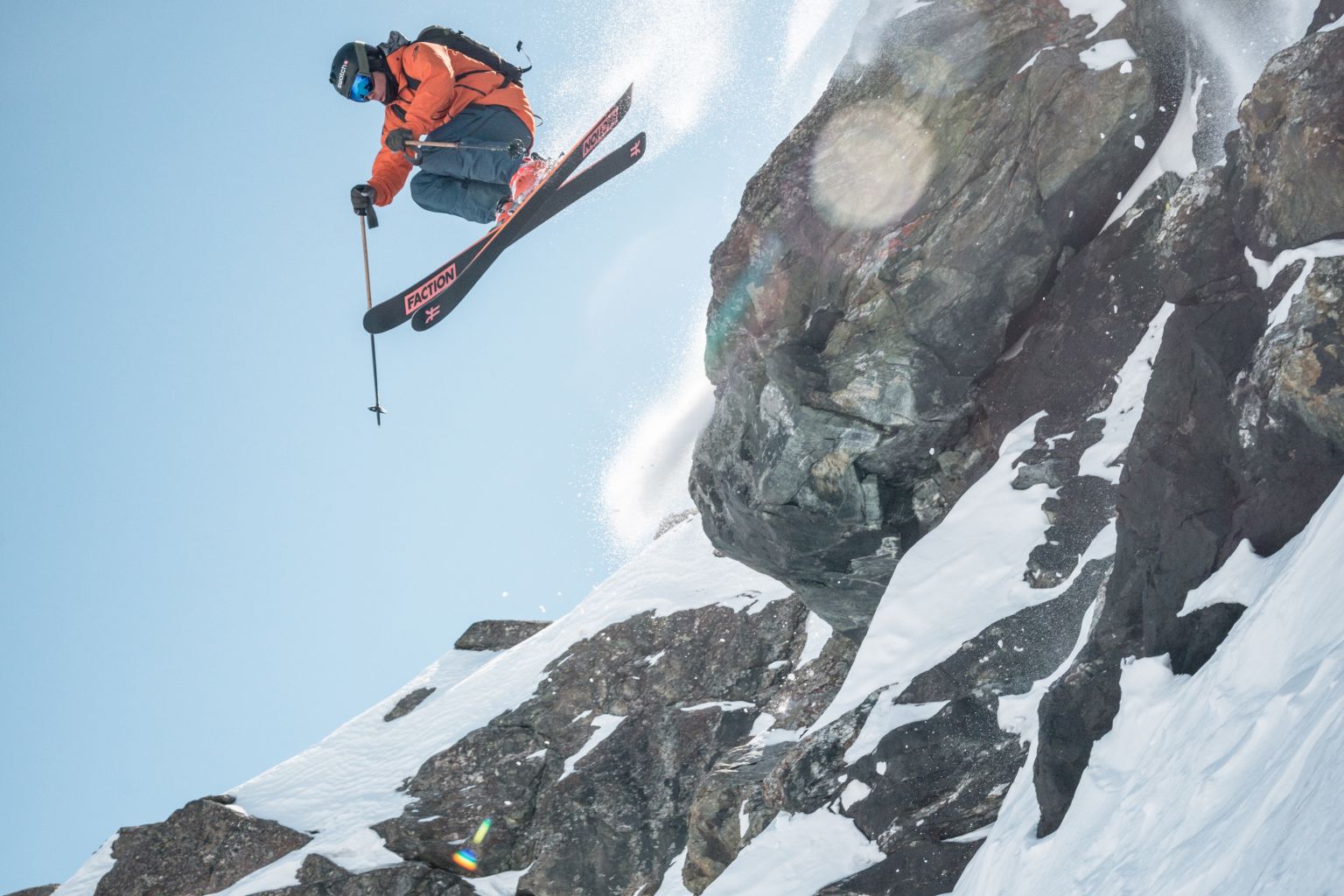A free spirit in paradise

Samuel Anthamatten, from Zermatt, is one of the world’s top freeride skiers. His sport demands extreme technical skill as well as great respect for nature. His playground: a pristine winter landscape that he knows inside out, through long climbs as well as exhilarating descents.
The Matterhorn soars in the cloudless sky, a mighty and menacing presence to all below. The sheer cliffs seem to address a warning to cheerful hikers: beware, the mountains are unpredictable. The dazzling sunshine sparkles on the white snow; the ice of the Gorner Glacier glitters in an unearthly shade of blue. All the raw beauty of the Alps meets the demands of modern tourism here at the foot of Switzerland’s most beautiful mountain: a place unlike any other.
Samuel gets his sporting thrills from his vertiginous descents, but the climbs up form an integral part of his spectacular runs. “Your body gets a natural warm-up,” he says, “you’re preparing it to give of its best.” More important still is the mental and technical preparation that the ascent offers: “As you climb up, you can tell how much snow there is and how firm it is, how solid the ice is and how stable the rock.” For Samuel Anthamatten, each freeride adventure is a long process that runs smoothest when you have scaled the mountain first under your own steam: “If you want to get to the bottom safely, you have to engage with nature on every level and sharpen all your senses.”

Samuel is the youngest of three brothers who have all devoted their lives to mountain sports. Simon (36), the eldest, is one of Switzerland’s most successful extreme mountaineers. In 2008, with Ueli Steck, he completed the first ascent of the north face of Tengkampoche in Nepal. Martin (35), the middle brother, is one of Europe’s leading ski mountaineers and a former World Champion. In 2010 he set a new record for the iconic Patrouille des Glaciers race from Zermatt to Verbier with Florent Troillet and Yannick Ecoeur: 5 hours, 52 minutes and 20 seconds for a distance of 53 kilometres and 4,000 metres of ascent. Their record was broken only in 2018. In trail running, Martin also holds the world record for more than 3,000 metres of ascent.

The brothers’ young sister Marillia (31), however, has no desire to compete with her brothers. “She is the only normal one in the family,” says Samuel with a smile. “And she’s very happy that way.” The Anthamattens have travelled the world and know the most spectacular mountain ranges on every continent. Yet they have always remained faithful to Zermatt, where they have their roots. “When I’m here, I feel at home,” says Samuel. “I know almost every rock and boulder here and I know exactly where and when the best runs are possible.” And with that he means the whole of Valais: “Most ski regions have one mountain that really attracts freeride enthusiasts; but here in Valais, we have 45 peaks above 4,000 metres and our options are almost endless.” That’s why Samuel won’t and can’t name a favourite freeride area or run: “We always decide the night before where we are going to go, and aim for terrain and conditions that are optimal for speed, pace and jumps.” The principle they follow is simple: “We go after the good snow and good weather, and then pick the slopes where we can best achieve the maximum number of good turns as safely as possible.” At the same time there are clear boundaries that must not be crossed. Samuel explains: “One boundary is set by the mountain and its topography; this limit moves upwards as you gain experience and skill.”

The other boundary, however, leaves no room for discretion: “When there is a risk of avalanches, we simply should not venture on to the terrain. Here, there’s just one principle: safety always comes first.” Samuel’s brother, Simon, applies this principle at the highest possible level in his main job – as a helicopter pilot for Air Zermatt. Samuel Anthamatten finds it “sad” that many people pay no heed to mountain dangers: “Going off-piste without suitable equipment is reckless.” All ski tourers should carry an avalanche rescue kit including avalanche transceiver, probe and shovel, he says: this is the number-one rule. Using the equipment often offers the only chance for a victim to survive an avalanche. “If you are buried by one, you don’t have much time. After just a quarter of an hour, your chances of survival plummet.” But even professionals run a certain risk: “When there’s an accident in the mountains, the consequences are usually serious.”
This knowledge and respect for nature certainly helped Samuel Anthamatten and his brothers achieve such success in the world of mountain sports. They also have their parents to thank: “They took us on walks in nature from a young age and helped us get to know the mountains in a fun way.” The parents’ message to their sons was always: “Do what you want, but do it properly.” The Anthamatten boys took the advice to heart: “We are all fanatical about what we do,” Samuel says with a laugh.

The appeal of the sport, for Samuel, lies in the overall experience in nature: “We spend six hours climbing the mountain – only to spend a couple of minutes skiing back down.” The descent requires a great deal of strength, energy and strong nerves. On the mountain slopes, mind and body alike are working at their absolute limits. The reward at the bottom of the run, however, is an almost indescribable sensation: “When you do your last few turns and reach the end of the run, it’s the most liberating and exhilarating feeling.” You experience a kind of weightlessness, Samuel says. He speaks with passion, enthusiasm and conviction. As you listen to him, you can almost feel the snow around you and the wind in your face. One thing is clear: if there is such a thing as pure happiness, it is to be found on the slopes of the Valais mountains.
Text: Thomas Renggli Photographs: David Carlier
Published: December 2019
The Valaisans who came in from the North
Next story

